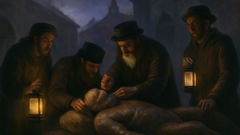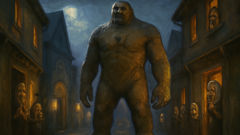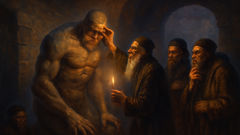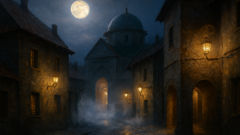Introduction
In the winding streets of Vilnius, Lithuania’s ancient capital, the stones still seem to whisper secrets from centuries past. If you wander the old Jewish quarter at dawn, when a mist hangs over the rooftops and the bells of St. Anne’s ring faintly in the distance, you might feel that something extraordinary once happened here—something that transcends time and reason. Long ago, beneath archways and in the shadow of spires, lived a people whose resilience and faith shaped the city’s soul. Among them walked a sage revered far and wide: the Vilna Gaon. Wise beyond measure, the Gaon’s days were spent poring over sacred texts, unraveling mysteries of the divine and mortal alike. But it was an era of unease. Whispers of violence and persecution echoed through the alleys. Night brought fear as much as it did rest. In this crucible of anxiety and hope, a legend was born—one that would bind the fate of Vilnius to clay, life, and the very limits of wisdom. This is the legend of the Golem of Vilnius: a tale of power awakened in desperate times, of a guardian raised from the earth, and of the thin line that divides protector from peril. As you read, let the cobblestones guide you back to a world where belief shaped reality and every shadow might hold a miracle—or a warning.
The Gaon’s Dilemma: A City in Peril
In the mid-1700s, Vilnius was a vibrant tapestry of cultures and faiths, yet its Jewish community walked a daily tightrope between tolerance and fear. The city’s Jewish quarter was a world unto itself—a labyrinth of synagogues, bakeries, study halls, and bustling marketplaces where Yiddish mingled with Lithuanian and Polish. In these narrow lanes, children played at dusk and elders gathered to share news, but beneath the lively hum lingered an anxiety born of history. Pogroms were not just distant rumors; they were recent scars.

The Gaon of Vilnius—Elijah ben Solomon Zalman—was already a legend in his own time. His study was a sanctum where light filtered in through a single window, falling on shelves heavy with sacred scrolls. The Gaon’s wisdom had saved many from despair, but even he couldn’t ignore the rising tension in the city. Stories spread of a new wave of violence stirring beyond Vilnius’s walls: a mob, led by superstitious outsiders, blaming the Jews for blighted crops and illness. Each day, the threat grew closer, and the Jewish council debated measures of defense.
One evening, as a storm gathered over the city and thunder rolled across the rooftops, the Gaon sat alone, turning over an ancient page. He was not a man given to fear, but the plight of his people weighed heavily on his mind. The council’s pleas echoed in his thoughts: “Rabbi, help us! We need a miracle, or at least a shield.” The Gaon knew the tales of Prague and the Golem made by Rabbi Judah Loew, a being of clay given life by Kabbalistic secrets. He’d always regarded these stories as allegory, but now desperation made him wonder—could such power be summoned here?
That night, the Gaon took a solitary walk to the banks of the Neris River. Lightning flashed, illuminating the city’s walls and reflecting off the water. He gathered his courage and uttered a silent prayer, asking for guidance. Tradition held that only one of unblemished faith and wisdom could attempt the ancient ritual. As he returned home, a strange resolve settled in his heart: he would try to save his people, not with violence, but with wisdom and the forgotten arts.
He shared his intent with only his closest disciples: Aaron, the scribe with steady hands; Miriam, a healer who knew the secrets of herbs; and Yosef, the cantor whose voice could move even the hardest soul. The Gaon led them to the oldest part of the quarter, where the earth was dark and untouched by recent graves. There, beneath a moon obscured by clouds, they dug deep into the clay-rich soil. With trembling hands, they shaped the mass into the form of a man—broad-shouldered, silent, and unseeing.
By lantern light, the Gaon traced Hebrew letters across the clay brow: ??? (emet), meaning “truth.” He whispered sacred words, and his disciples joined in, their voices weaving through the night air. The earth seemed to tremble as the final syllable faded. The clay figure shuddered. Eyes like river stones flickered open, glimmering with an otherworldly spark. The Golem of Vilnius had awoken.
The Clay Guardian Rises: Hope and Fear
The Golem’s awakening sent a shiver through those gathered. It rose slowly, limbs creaking like ancient boughs, silent yet attentive to its creator’s every gesture. The Gaon named it Adam, for it was earth and breath—man’s first shadow. Adam towered above even the tallest men, his skin mottled with the colors of riverbed clay, features broad and undefined, yet unmistakably alive.

Aaron, Miriam, and Yosef exchanged uncertain glances. The Gaon explained the Golem’s purpose: it was to protect, not harm; to be a silent sentinel at the quarter’s edge. For days, Adam stood watch in the alleys and at the main gates, his heavy footfalls echoing long after dusk. Children peered at him from windows, torn between awe and fear. Some whispered prayers for his blessing; others hid, wary of what power had been summoned.
Word spread quickly through Vilnius. Merchants and elders marveled at the giant, whose presence seemed to steady nerves and embolden hearts. When a fight broke out in the marketplace, Adam intervened with gentle strength, parting the crowd without a word. His hands, though massive, never struck; instead, he calmed tempers with his silent stare. Gradually, stories filtered back to the Gaon: the Golem had foiled several thefts, scared off rowdy outsiders, and even carried water for the old and infirm. For a while, hope blossomed in streets once thick with anxiety.
But not everyone welcomed this new protector. In the city’s upper halls, whispers of sorcery and unnatural acts began to circulate. The Bishop of Vilnius sent envoys to inquire about the “clay demon” rumored to haunt the Jewish quarter. The Gaon responded with humility, insisting that Adam was nothing more than a symbol of their faith and resilience. Yet he knew the truth—and he knew that even good intentions could spiral beyond control.
As spring waned, tension returned. The hostile mob from the countryside finally descended on Vilnius, armed with torches and sharpened tools. The Golem met them at the gate. What followed became the stuff of legend: Adam absorbed blows that would have felled any man, lifted wagons to block the entrance, and shielded families huddled behind crumbling walls. The mob, terrified by his immensity and silence, fled into the night. The quarter rejoiced, singing songs of deliverance. The Gaon was hailed as a miracle worker.
Yet, beneath the celebration, unease simmered. Miriam noticed that Adam now moved differently—slower, less responsive to commands. Sometimes he wandered at night, standing for hours by the river or staring at the moon. Yosef reported hearing low, mournful groans when no one else was near. Aaron confessed that he’d seen the clay under Adam’s eyes darken and crack, as though the weight of his task was wearing him down. The Gaon began to worry: had he gone too far? Was it possible that even a being fashioned for good could become a vessel for sorrow or rage? The answer, he feared, was buried in the Golem’s unspoken silence.
When Power Outpaces Wisdom: The Golem’s Reckoning
As weeks passed, Adam’s behavior grew more unpredictable. The Gaon spent sleepless nights searching ancient texts for guidance, finding only cryptic warnings about the dangers of playing at creation. He recalled a passage: "To awaken what sleeps beneath the earth is to invite its shadow to linger." The words gnawed at him as he watched his clay guardian become less responsive to commands, wandering at odd hours and standing motionless in hidden corners.

Aaron, ever practical, suggested reinforcing Adam’s instructions with new incantations. Miriam tried herbal remedies—placing sprigs of rue and lavender in the Golem’s path—but Adam ignored them, his heavy gaze fixed on some distant point. Yosef sang haunting melodies in Hebrew, hoping to soothe whatever troubled spirit animated the clay, but the Golem remained unmoved.
One evening, as a crimson sunset bled across Vilnius, Adam stood in the main square, surrounded by curious townsfolk. A group of children approached him, giggling nervously. Suddenly, the Golem let out a guttural sound—half groan, half sigh—and turned away, shuffling toward the riverbank. The children scattered in fear. That night, rumors ran wild: the Golem had grown dangerous.
The next day, when the Gaon sought out his creation, he found Adam knee-deep in the river’s mud, arms outstretched as if reaching for something lost beneath the water. The Gaon called to him in Hebrew, commanding him to return, but Adam remained rooted. Only when the Gaon invoked the sacred Name did the Golem slowly turn and trudge back to his post, dripping with river silt.
The final test came not from without, but from within the quarter. One of the local councilmen, emboldened by the Golem’s presence, began to wield his newfound safety as a weapon against his rivals, demanding tribute for "protection" and threatening to have Adam intervene. The Gaon learned of this abuse with deep sorrow. He realized that any power—even power meant to save—could be twisted if unchecked by humility.
That night, he gathered his disciples one last time. In a chamber lit by a single candle, the Gaon revealed the truth: the Golem’s heart was not merely clay, but the hopes and fears of all who relied on him. To preserve what was right, he would have to undo what he had made. With trembling hands, the Gaon erased the first letter from Adam’s brow—changing ??? (emet, "truth") to ?? (met, "death"). The Golem shuddered, let out a long, low moan, and then collapsed into a heap of lifeless clay. A hush fell over the city.
The Gaon’s disciples wept for their fallen protector. The next morning, the Jewish quarter awoke to find Adam gone—his clay quietly returned to the earth in the oldest courtyard, hidden beneath a new layer of cobblestones. The Gaon spoke little of what had transpired. He told his followers: "True strength is not in what we create, but in knowing when to let go."
Conclusion
To this day, Vilnius carries whispers of its clay guardian. Some say that on foggy nights, you can spot footprints too large for any man near the old courtyards or hear faint echoes of a giant’s tread in silent alleys. But the true legacy of the Golem is not in vanished clay or hidden tombs—it lives in stories passed from parent to child, in lessons woven through generations: that power and wisdom must walk hand in hand, and that even the purest intention can become a burden if wielded without humility. The Gaon of Vilnius remains a symbol not just of scholarship and faith but of understanding limits—the courage to intervene and the greater courage to let go. In remembering the Golem, Vilnius remembers its own heart: resilient yet vulnerable, ever seeking harmony between strength and compassion.













